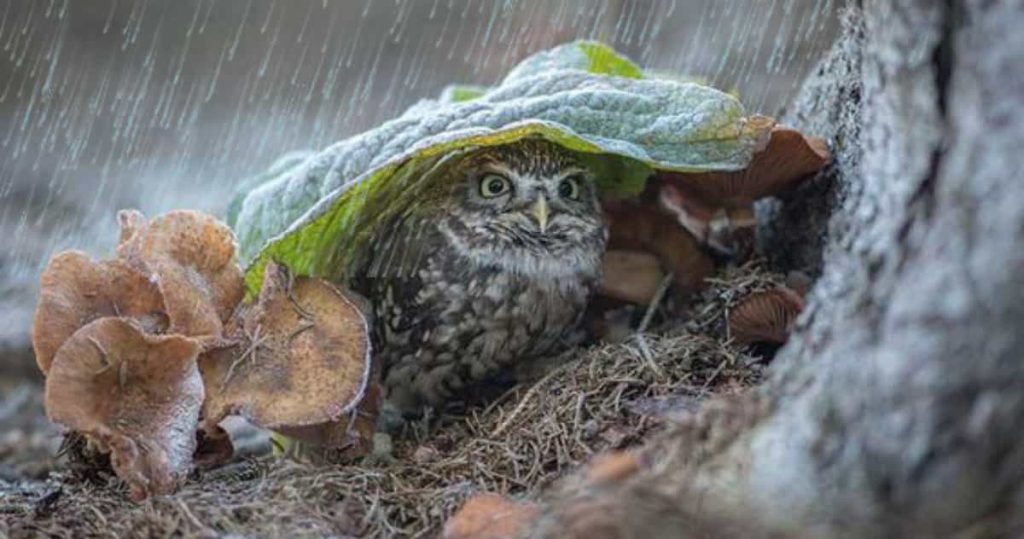
With the change of season, like all wild animals, owls sometimes have to get wet in the rain even if they don’t want to. But the question may come into many people’s minds Can owls fly in the rain?
While rainwater cools the owl’s body and controls various types of parasites that live in the owl’s body, too much rain can cause owls to suffer from deadly diseases.
Being a bird lover, I had the opportunity to see owls closely. I am going to describe How Owls Survive in the Rain in this post.
For example, I will present a vivid idea about owls relating to whether they like to go out in the rain, whether they hunt in the rain, whether they hoot in the rain, whether they mate in the rain, and what kind of diseases may put them at risk in the rain.
This will help you get complete information about an owl’s life in the rain.
Contents
- 1 Can owls fly in the rain?
- 2 Do owls come out in the rain?
- 3 Do owls hunt in the rain?
- 4 Do owls hoot in the rain?
- 5 Do owls live in rainforests?
- 6 Do owls sit in the rain?
- 7 Can owls mate in the rain?
- 8 Why Do Owls Spread Their Wings in the Rain?
- 9 Are Owls Active in the Rain?
- 10 Why Do Owls Come Out in the Rain?
- 11 Risks of Rainy Weather for Owls?
- 12 Where do owls go when it rains?
- 13 FAQ
- 14 Conclusion:
Can owls fly in the rain?

Owls can fly easily in light rain, and if the amount of rain increases, owls do not have water repellency in their feathers like ducks, so their feathers become wet and heavy, making flight difficult.
Owls do not hunt when it rains. If it rains while hunting, owls are famous for being efficient hunters in dry conditions and cannot hunt effectively in wet conditions.
Owl feathers are designed in such a way that even if the feathers get wet with rainwater, they will dry easily.
Rainwater weakens owls’ vision, making it difficult for them to find directions. What species of owls are known as owls in the rain?
Several species of owls have a waxy coating on their feathers, so their feathers do not get wet easily. All these species of owls have been observed hunting in relatively low rainfall.
However, they find it very difficult to hunt in the rain, and sometimes they become divots. The sound of rain makes it difficult for them to determine the exact location of their prey, and the rainwater does not allow them to see clearly. All these owls are named as follows:
- Barn owl
- Great horned owl
- Eurasian eagle-owl
- Tawny owl
Do owls come out in the rain?
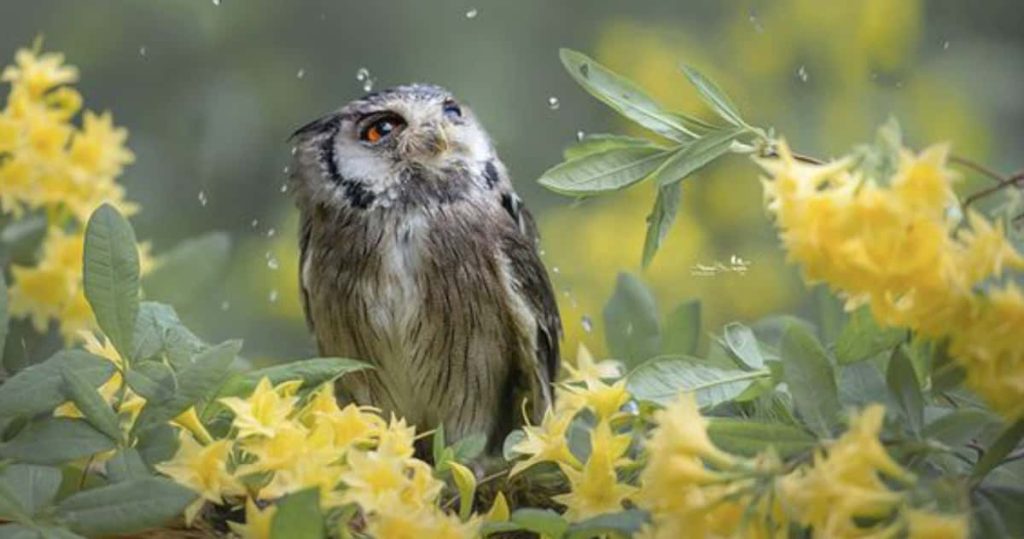
Owls are not aquatic birds, so their bodies do not produce preen oil like waterfowl to protect their body feathers from getting wet. That’s why owls don’t like to get wet in the rain easily.
When owls get wet in the rain, their feathers do not absorb the water, which makes their bodies heavier, making it very difficult for them to fly.
When rainwater enters an owl’s habitat, the owls move out and take shelter in a water-resistant area. They wait for the rain to stop. When the rain stops, they arrange their feathers to dry and prepare to catch prey again.
Do owls hunt in the rain?
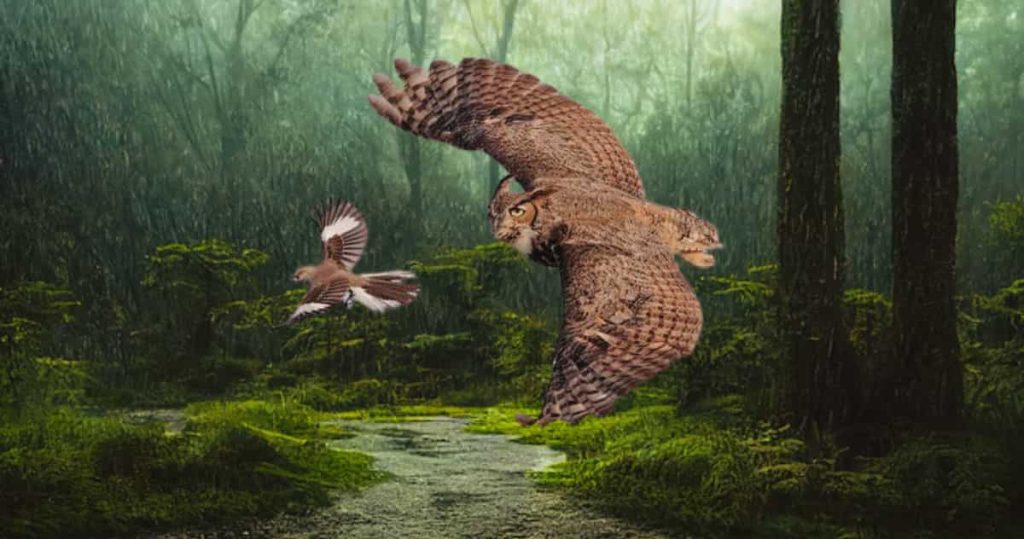
Owls avoid hunting in the rain and do not like to leave their shelters. But if it rains while hunting and if the amount of rain is less, then the owls focus more on hunting.
If the amount of rain is too much, then they no longer chase the prey. Then they look for shelters, and when they find waterproof shelters, they wait until the rain stops.
There are several species of owls which are counted as fishing owls. These fish-hunting owls also do not like to get wet.
For this reason, the rainy season is a difficult time for hunting and habitat after the winter for all owls. Because of this, the owls fight for shelter in the winter and the barn.
Do owls hoot in the rain?
Owls typically hoot during the breeding season to attract mates and to threaten other owls to defend owl territories.
Owls are not seen hooting during the rain. Owls don’t hoot for no reason because it can alert their prey.
If there is a possibility of being attacked by a predator, owls can often use defensive hooting to scare off the predator and alert that animal.
If hooting doesn’t work, they use their sharp claws and beaks to defend themselves against predators.
Owls become more aggressive in the course of the breeding season to protect owlets, They keep hooting to call mates to scare off predators.
Do owls live in rainforests?
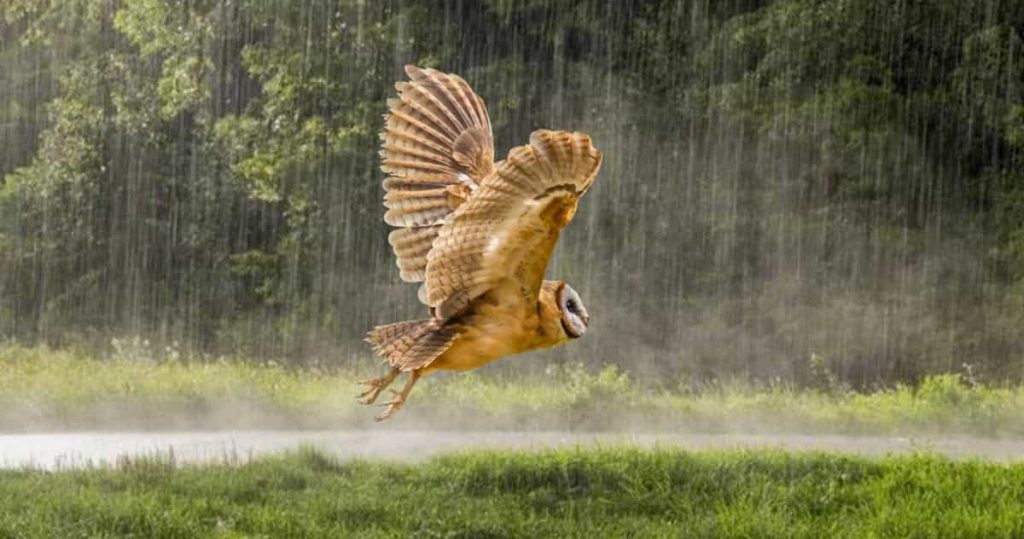
Owls generally do not like to get wet in the rain, so rainforests are not their preferred habitat.
Because it rains regularly in the rainforests which can trouble owls and make them sick, owls ignore the geographical environment of regular rain.
Researchers are doing an investigation on the possibility of owls living in rainforests such as the Amazon basin.
Researchers have found a species of spectacled owl, scientifically named Pulsatrix perspicillata, in the Amazon rainforest.
They have adapted very well to the rainforest ecosystem, like Barn Owl, Great Horned Owl, Screech Owl, etc.
Other species of owls are not easily seen in rainforests because of their difficulty in hunting and they keep looking for rainwater-proof shelters.
Do owls sit in the rain?
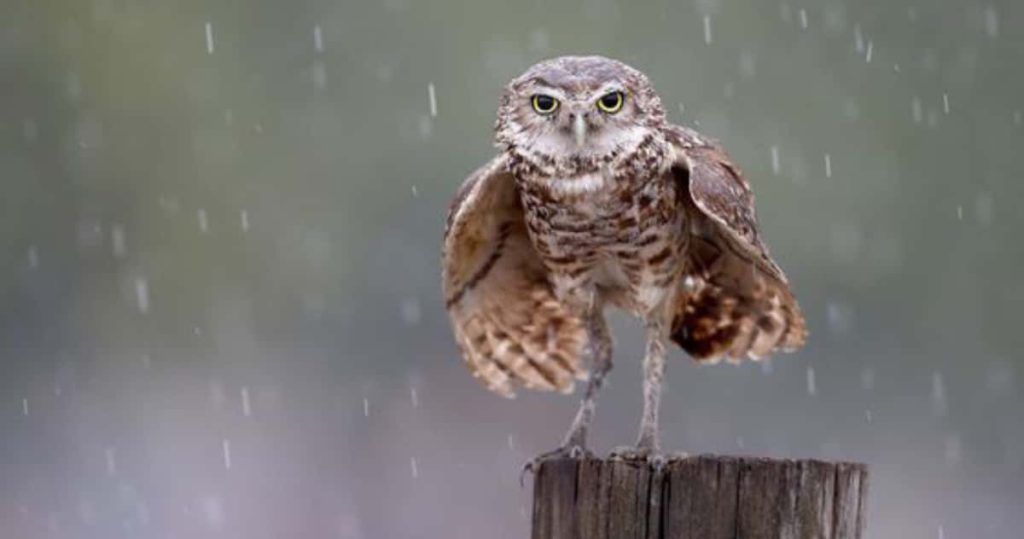
In summer, owls are often seen sitting in the rain to escape the heat and remove parasites, but owls do not like to be wet or sit in the rain at all.
Owls do not have water-repellent feathers in their feathers, so their feathers become heavy when wet by rainwater. This causes problems when owls fly; even owls cannot hunt properly.
A waxy coating on the feathers of some species of owls, such as the barn owl, prevents their feathers from getting wet as easily. That’s why, even if they get wet, their feathers are relatively dry.
And other species of owls have relatively less waxy covering that doesn’t make their feathers waterproof. Such is the reason why other species of owls get wetter.
But one good thing about owls is that they can trap air and dry their body feathers easily. Besides, they sometimes sit somewhere and play with their wings, bathe in the sun, and dry their feathers.
Can owls mate in the rain?
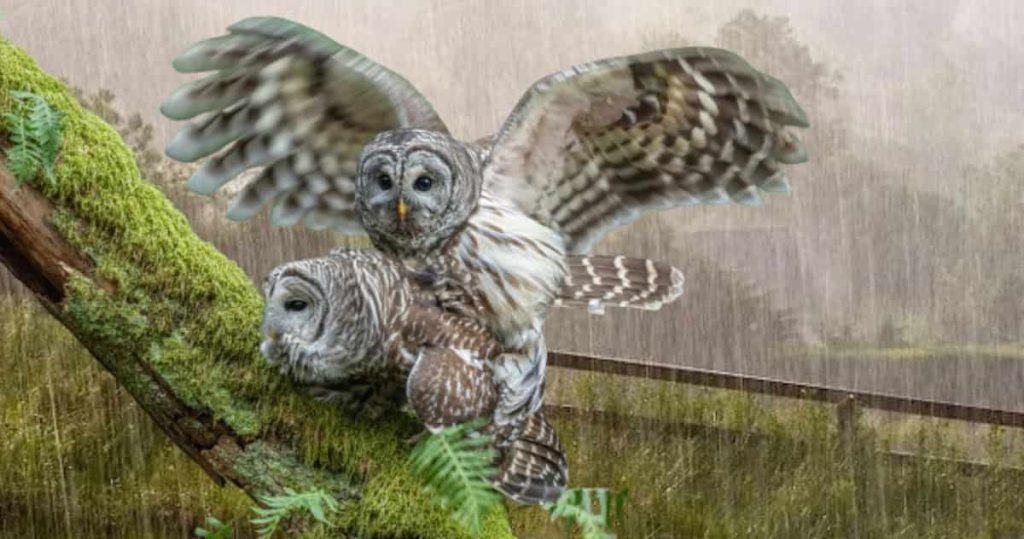
The rainy season is not an ideal time for owls to mate. They do not mate by getting wet in rainwater. But if two mate owls live together in the same place, they can mate if they both want to.
If more than one owl lives in an area, competition for mates starts, which is why they may not choose a specific time to mate, i.e., they may mate during rain.
Owls seek water-resistant places such as tree hollows or caves to mate even during rain, where they can mate without getting wet and away from predators.
However, the ideal time for owls to mate is from November to March. During this time, many owls keep looking for mates, nesting, and raising owlets.
Why Do Owls Spread Their Wings in the Rain?
If you see an owl getting wet in the rain, you will see the owl spreading their two wings and making a canopy.
In this way, owls make a canopy of their bodies so that rainwater rolls down from above and other feathers of the body do not get wet.
And just as other animals vibrate their bodies to get rid of excess water, owls sometimes vibrate their bodies.
Common owls tend to stay wet when the rain has come and there is no nearby shelter to shelter them from.
The canopies that owls make with their wings allow water to drain easily from their body feathers and help the feathers to dry very quickly.
Are Owls Active in the Rain?
Owls do not like to get wet at all. So they prefer to take shelter in rain-protected areas. Rain makes owls’ feathers wet and heavy, and due to rain, the visibility of the hunting area becomes very low, making it difficult for owls to see.
Also, it becomes difficult for owls to hear and smell their prey because of the constant rain.
If the owls are wet for a long time in the rainwater, their bodies may develop various diseases. Even if the owls are wet for a long time in the rain, their chances of losing their lives also increase.
Owls become easy prey for other predators when wet from rain. They will not be able to easily fight predatory animals due to being wet and will not be able to easily fly away.
So owls prefer to rest in a sheltered place rather than hunt, especially during the rain.
Why Do Owls Come Out in the Rain?
Owls do not like to go out in the rain unless it becomes necessary.
If owls become very hungry and prey comes within range of the owl to seek dry shelter to escape the rainwater, the owl may venture out into the rain to hunt.
If rainwater enters the owl shelter and the rain continues for a long time, the owls will come out and seek dry shelter.
If a predator enters the owl’s shelter, the owl has to come out of the nest for its life.
Again, even if it rains during the breeding season, they have to come out of the nest to collect food and ward off other predators to keep their babies.
Owls are very aware of their territory, and if another owl moves into their territory, the owl has to come out, even in the rain, to drive them away.
To cool down in summer, owls often come out of their nests voluntarily to wet themselves, thereby cooling their bodies.
Risks of Rainy Weather for Owls?
Rainy weather is often alarming for owls. The problems that owls can face in the rain are stated below.
If an owl gets wet in rainwater for a long time and does not find a dry shelter, the owl may catch a cold and suffer from hypothermia, which can be life-threatening.
- If the owl’s feathers are wet for long periods, the feathers can harbor a fungus that destroys the feathers, making it difficult for owls to fly.
- Due to the rain, the victims do not come out of their habitats, because of which owls lack food and, at times, have to starve.
- Many times the habitat of owls gets wet, which makes it difficult for them to stay inside the nest, and they have to look for new nests.
- Owl feathers become heavy when wet with rainwater, making it difficult for them to fly. Although they are skilled hunters, they cannot catch prey properly.
- Owls cannot fly properly when wet with rain, making them easy prey for predators.
- Rainy weather during the breeding season puts the owls at risk as rainy weather does not provide proper food availability and the chicks are prone to getting wet and sick.
- The sound of raindrops does not make owls understand the sounds of their prey. That’s why they do not understand the movement of the prey.
- Owls’ eyes have evolved to see better in low light, but rain can reduce the transparency so much that owls cannot see their prey properly.
- Tree branches become slippery in the rain, which decreases the chances of an owl landing on a particular spot.
Where do owls go when it rains?
Owls take refuge anywhere in the environment, including low-noise human habitats. So that owls can rest safely and escape from predators. However, the habitat of owls may change depending on the species.
Owls don’t like to get wet. When it rains, owls look for water-proof shelters to keep their bodies warm. As the owls come to human habitations, they generally take shelter in the unoccupied part of the house, under a bridge.
Owls living in a park or forest take shelter in tree hollows, caves, bushes, etc. where rainwater does not reach and escape from predators. When the rain stops, the owls go elsewhere to hunt.
FAQ
Q. Are owls afraid of rain?
Ans: Although owls face many difficulties due to rain, they are unafraid of it.
Q. What do Owls do while it rains?
Ans: Owls prefer to stay inside the nest when it rains without getting wet.
Q. Do barn owls fly in the rain?
Ans: All species of owls, including barn owls, can fly in the rain when needed.
Q. Why don’t owls date in the rain?
Ans: Owls don’t usually date in the rain because they don’t like to get wet in the rain. However, if desired, owls can date in tree trunks or in a cave where rainwater cannot enter.
Q. Do short-eared owls hunt in the rain?
Ans: Although short-eared owls can hunt in the rain, they do not hunt in the rain unless necessary.
Conclusion:
Above, I have given detailed information about how owls survive in the rain, such as: Can owls fly in the rain? Which will help you to know all the information about the life of owls in the rain.
The owl’s movement in the rain can vary as per the species of owl. While most species of owls are not active in the rain, several species have been observed to be active.
However, owls that are active in the rain do not dare venture out during the rain unless it becomes necessary.
We can make the lives of the owls comfortable if we want, like making rainwater-proof wooden nests for the owls so that they can stay comfortably in our nests during any natural calamity.